How AI Predicts Weather for Smarter Irrigation
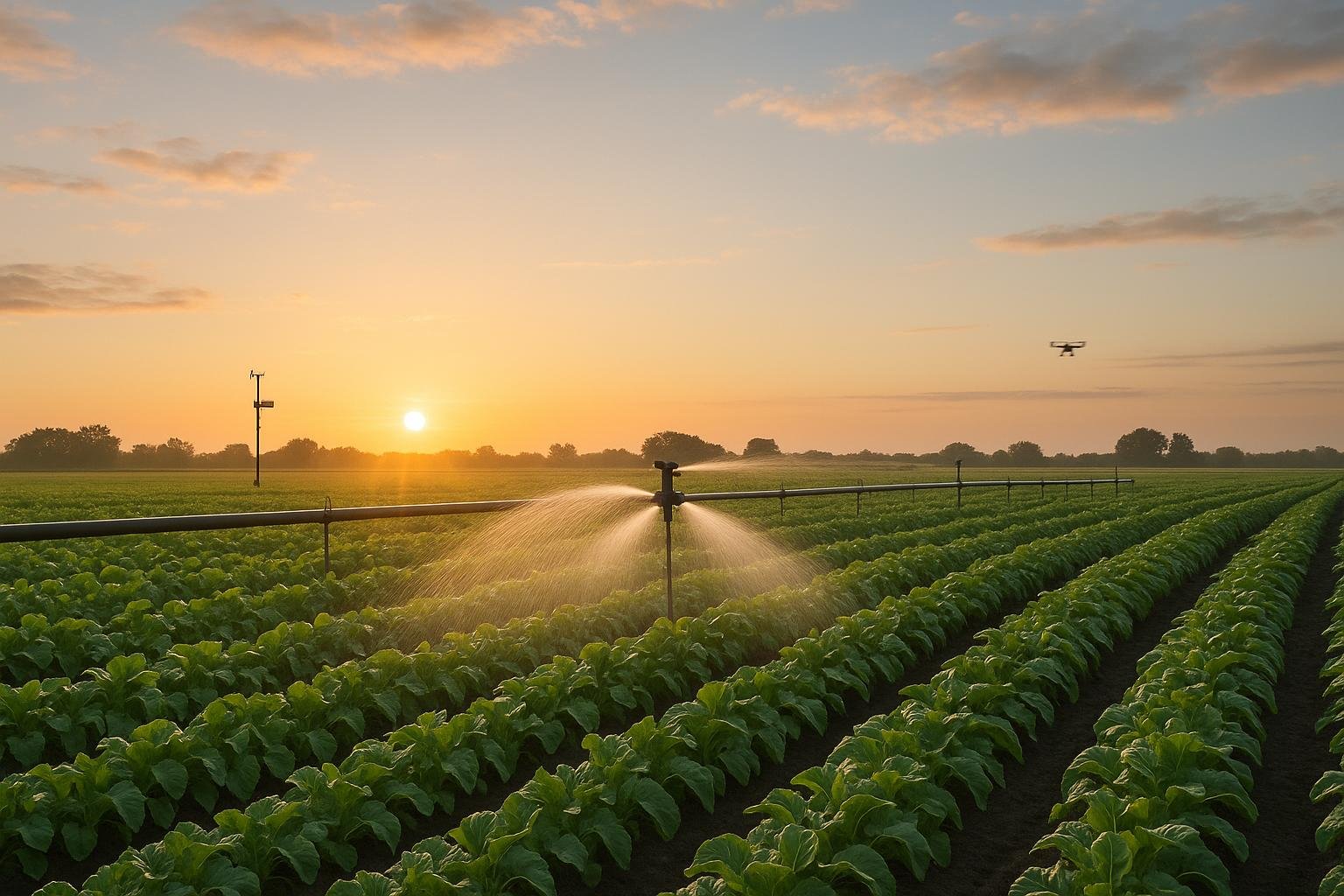
AI is transforming irrigation by using weather predictions to save water, boost crop yields, and cut costs. Here's how:
- Water Savings: AI systems reduce water usage by up to 50% through precise irrigation schedules.
- Higher Yields: Farmers report 20–30% increases in crop yields by delivering water exactly when and where it's needed.
- Cost Efficiency: Automation lowers labor costs and energy use, with savings of up to 40% on water-related expenses.
- Weather Forecasting: AI analyzes weather data, such as temperature, humidity, and rainfall, to optimize irrigation timing.
- Advanced Tools: Systems integrate data from satellites, sensors, and drones to provide real-time insights, even in remote areas.
AI-powered irrigation is already helping U.S. farmers handle challenges like droughts, extreme weather, and water scarcity. From almond growers in California to corn farmers in Kansas, these tools are reshaping agriculture by improving efficiency and productivity.
AI Agents for Precision Irrigation Systems

How AI Predicts Weather for Irrigation
AI is reshaping how weather predictions are used for irrigation by diving deep into vast amounts of historical and real-time weather data. This allows it to uncover patterns that traditional methods often overlook, leading to smarter irrigation schedules that save water and keep crops healthier.
AI Algorithms and Weather Data Analysis
Machine learning is at the heart of AI's ability to analyze weather data. By examining factors like temperature, humidity, wind speed, and atmospheric pressure, AI can pinpoint water requirements with impressive accuracy. These algorithms don’t just crunch numbers - they interpret environmental variables to make precise irrigation recommendations.
"AI algorithms use historical data to predict weather patterns and irrigation requirements accurately." – DripWorks [1]
A great example comes from Taiwan, where researchers developed a hybrid model combining a Convolutional Autoencoder and LSTM-based Transformer Network (CAE-LSTMT). Using data from 2020 to 2023, this model improved temperature forecasts by 5.66%–20.39% and relative humidity forecasts by 8.05%–12.76%, outperforming traditional LSTM models. It also excelled in predicting vapor pressure deficits, enabling more accurate irrigation timing and reducing stress on crops [4].
This type of advanced analysis sets the stage for integrating multiple data sources into a unified system.
Data Integration from Multiple Sources
AI-powered irrigation systems pull data from a variety of sources - weather satellites, ground sensors, drones, and numerical weather prediction models - to create a detailed view of current and future weather conditions [5].
Take Climavision as an example. This system processes over 1.5 billion global observational datasets every day, including unique inputs like space-based data. With rigorous quality control, Climavision boosts the amount of usable data to over 20%, compared to just 3% from government sources [5].
The integration process involves collecting and refining diverse data types, such as temperature, humidity, wind speed, and atmospheric pressure. AI then identifies patterns and relationships that might otherwise be missed, providing farmers with real-time weather insights - even in remote areas [5].
Predicting Weather Events
AI excels at forecasting weather events that directly impact irrigation, such as droughts, heavy rains, and frost. For instance, AI models analyze climate and soil moisture data to create drought indices, helping farmers anticipate and manage water shortages [6].
In Alice Springs, Australia, researchers demonstrated AI's potential in drought prediction. By analyzing climate data from 1985 to 2020 and soil moisture data from 2005 to 2020, they developed a generalized linear model-based index. This index achieved a correlation coefficient of 0.78 with upper soil moisture levels, outperforming traditional drought indicators and offering more reliable guidance for decision-makers [6].
Rainfall prediction is another area where AI shines. Long Short-Term Memory (LSTM) networks are particularly effective, being used 21% more frequently than other machine learning models for rainfall forecasting. Between 2023 and 2024, studies utilizing LSTM networks increased by 150% [7]. These networks can identify complex rainfall patterns, allowing farmers to adjust irrigation schedules - reducing water usage before expected rain or increasing it ahead of dry spells.
AI's predictive capabilities don’t just help with immediate irrigation needs; they also provide longer lead times for severe weather events. This gives farmers the chance to plan ahead, whether it’s for seasonal resource allocation or making quick adjustments in response to real-time data [5].
Benefits of AI-Powered Irrigation Systems
AI-powered irrigation systems bring major advancements in water conservation, crop health, and operational efficiency. These improvements not only support farmers' profitability but also contribute to reducing environmental impact.
Water and Energy Savings
One of the standout advantages of AI-driven irrigation systems is their ability to minimize water waste through real-time precision adjustments. By continuously analyzing factors like soil moisture, weather forecasts, and plant needs, these systems prevent common issues such as over-irrigation and runoff that are prevalent with traditional methods [1].
Farmers using AI-optimized irrigation report water savings ranging from 25% to 50%, with advanced systems achieving the upper limit of this range [8][9]. Reduced water use also means lower energy consumption. For example, low-pressure drip emitters powered by AI can cut pumping energy use by over 50%, while precision irrigation controllers can lower water consumption by more than 40% [3]. This combination of water and energy efficiency translates into significant cost savings, which is especially critical as utility expenses continue to rise.
Municipalities are also leveraging AI for smarter water management. Many report up to 40% reductions in water loss through AI-powered leak detection and monitoring systems [8]. These tools identify inefficiencies in real time, helping to prevent the unnoticed water losses that often occur in older systems.
"With VODA.ai's daVinci machine learning technology, we will be able to make smart decisions, save valuable resources, and protect our water infrastructure." – Tim Thomure, previous Director of the Tucson Water Department [10]
These water and energy efficiencies not only reduce costs but also create better conditions for crops, as explored in the next section.
Better Crop Yield and Plant Health
AI-powered precision irrigation ensures plants receive the exact amount of water they need at the right time. This approach eliminates both under-watering and overhydration, resulting in healthier plants and a 20–30% boost in crop yields [3][9].
A real-world example of this impact comes from a 2017 collaboration between Microsoft and ICRISAT. Farmers in seven villages were sent AI-calculated recommendations for optimal sowing dates and irrigation schedules. Despite poor rainfall, these farmers saw a 30% increase in yields compared to traditional methods [1].
AI systems also enhance pest and disease management. For instance, Farmonaut combines satellite-based crop monitoring with AI-driven advisory tools to help farmers make informed decisions about irrigation, fertilization, and pest control [2]. Additionally, AI can synchronize water and fertilizer application, ensuring plants receive balanced nutrition for optimal growth.
By improving crop health and boosting yields, these systems not only increase productivity but also reduce input costs, making farming operations more efficient overall.
Cost Reduction and Automation
AI-powered irrigation systems can lower operational costs by 30–50% while increasing productivity by 20–30% [9].
One major area of savings is labor. Traditional irrigation methods require frequent manual adjustments and monitoring, but AI systems operate autonomously. They adjust watering schedules automatically based on weather, soil conditions, and plant requirements, freeing up valuable time for farmers.
AI also reduces chemical usage. By integrating drone-based hyperspectral imaging with AI algorithms, farmers can cut chemical application by up to 50%, which lowers costs and reduces environmental harm [9].
The growing adoption of smart irrigation reflects these benefits. The market, valued at $1.86 billion in 2024, is projected to grow to $2.16 billion by 2025 - a growth rate of over 16% [12]. Case studies highlight the technology's impact: in California, a vineyard reduced water usage by 35% with an AI-based system while maintaining crop quality [11]. Similarly, a large Australian farm used satellite AI analysis to identify areas of water stress, cutting irrigation by 25% while improving crop uniformity [11].
AI integrates tools like weather forecasting, soil sensors, and crop monitoring to optimize irrigation timing and volume, ensuring maximum efficiency.
| AI Application | Efficiency Improvement |
|---|---|
| Leak Detection | 20–60% water savings |
| Precision Controllers | Over 40% reduced consumption |
| Low-Pressure Drip Systems | Over 50% energy savings |
sbb-itb-4d6a8dd
🚀 Ready to Reinvent Your Garden?
Join thousands of homeowners who have transformed their gardens using our AI design tool. Upload one photo to explore endless possibilities.
Get your AI garden designs →Applications in US Agriculture
AI-powered irrigation systems are reshaping farming practices across the United States by adjusting to varying climates and crop needs, all while improving water efficiency and boosting productivity.
Case Studies of AI-Driven Irrigation
Real-world examples highlight how AI-driven irrigation is making a difference on American farms. In Idaho, a farmer managing 6,500 acres uses aerial visuals and thermal imaging to monitor crops. The AI system analyzes this data to detect issues like pivot-related leaks, providing precise alerts. This approach has transformed large-scale field monitoring, eliminating the need for time-consuming manual inspections [13].
In California, an almond grower adopted a precision irrigation system that combines soil moisture sensors, weather data, and satellite imagery. By leveraging AI algorithms, the system optimized irrigation schedules, saving 20% of water and increasing yields by 10%. It also improved the size and quality of the almonds [2].
Kansas farmers using satellite-based AI technology have reduced water usage by as much as 30% while maintaining or even improving crop yields [14]. Meanwhile, in Alabama, small-scale corn farmers rely on AI advisory tools to guide decisions on fertilizer use, pest management, and harvest timing. These tools have resulted in better yields and higher-quality crops [14].
These examples underscore how AI can adapt irrigation strategies to meet the unique demands of different regions across the United States.
Local Solutions for Different Climates
AI systems are designed to respond to the diverse climates found across the country, offering tailored solutions for each region.
In the arid Southwest, where summer temperatures often soar above 110°F, AI prioritizes water conservation and heat stress management. These systems ensure water is used efficiently, even under extreme conditions.
The Great Plains face challenges like variable rainfall and sudden weather shifts. In states such as Kansas, AI systems incorporate long-term weather forecasts to help farmers anticipate droughts or abrupt changes, enabling them to adjust irrigation schedules proactively.
In the humid Southeast, overwatering can lead to disease pressure. AI systems here monitor factors like leaf wetness and canopy temperature to optimize irrigation timing, reducing the risk of fungal infections.
California’s Central Valley, with its Mediterranean climate, benefits from precise irrigation scheduling. AI systems account for the region’s distinct wet and dry seasons. Jingyi Huang, an associate professor of soil science, explained the potential of these technologies:
"Our project is going to deliver a soil moisture map with an extremely high spatial and temporal resolution. We are using AI and satellite data to gather this information and give it to farmers." [15]
AI also fine-tunes various irrigation methods - whether it’s center pivot, drip, or sprinkler systems - by adjusting water distribution rates based on local conditions. For example, in high-temperature regions, irrigation is scheduled during cooler parts of the day to minimize evaporation. In colder areas, soil temperature monitoring helps protect crops from frost damage.
Challenges and Future Prospects for AI Irrigation
AI-powered irrigation systems hold the promise of transforming agriculture, offering greater efficiency and resource management. However, their adoption across the U.S. faces several challenges. Understanding these obstacles, alongside the latest developments, sheds light on the direction this technology is heading.
Limitations of Current Systems
One of the biggest barriers to adopting AI irrigation systems is their high upfront cost. Depending on the size and complexity, implementation can range from $30,000 to over $300,000 [16]. This price tag often puts these systems out of reach for small and medium-sized farms.
Technical issues also play a role. For instance, sensor calibration errors can lead to inaccurate readings of soil moisture, temperature, or pH levels, which undermines effective irrigation decisions [9]. Adding to the complexity, many farmers lack the technical expertise needed to operate these advanced systems confidently.
Infrastructure limitations further complicate matters. In rural areas, unreliable internet connectivity, inconsistent power supplies, and limited access to technical support can disrupt system performance [9]. Data security concerns also weigh heavily, as farmers worry about protecting sensitive information related to their crops and fields. Additionally, legacy equipment often struggles to integrate with modern AI systems, forcing farmers to either invest in costly upgrades or work with disconnected tools.
Despite these challenges, advancements in technology are beginning to address many of these issues.
Advancements in AI and Sensor Technology
Recent breakthroughs in machine learning are helping to overcome some of these hurdles. For example, new algorithms can now translate six-hour weather simulations into precise hourly forecasts with up to 96% accuracy for heat index predictions [4]. This level of precision is a game-changer for making informed irrigation decisions.
Sensor technology is also improving rapidly. Modern sensors are not only more accurate but also require less frequent calibration, making them more reliable over time - even in tough field conditions. Additionally, AI models are achieving supercomputer-level accuracy while using less energy and time [17].
However, challenges remain. As Ashesh Chattopadhyay from UC Santa Cruz points out:
"AI is quite amazing, not just for language but also for science. AI weather models are a testament to that. But there is still a lot that is different in the physical sciences as compared to language and vision, and there are still physical inconsistencies that we need to reconcile with. We are working on the rigour and mathematical foundations of these models - there is more that needs to be done." [17]
Efforts to improve transparency through Explainable AI (XAI) are also making a difference. By clearly showing how AI systems arrive at their recommendations, XAI helps build trust and confidence among farmers.
The Future of AI in Irrigation
With these advancements, the future of AI-driven irrigation looks bright. By 2025, it's estimated that over 60% of American farms will adopt precision agriculture technologies powered by AI [18]. Lower costs and improved accuracy - such as a predicted 30% boost in yield prediction accuracy - are making these systems more appealing and practical for farmers [18].
Standardization efforts are another key development, making it easier to integrate AI systems with existing tools. Still, some challenges persist, such as ensuring consistent predictions in real-time data fusion, achieving better interoperability, and adapting weather models to specific regional conditions [9].
The environmental benefits of AI irrigation systems are also hard to ignore. These systems can cut water usage by up to 50% while increasing productivity by 20–30% [9]. As they become more affordable and better suited to local needs, AI irrigation is poised to become a common feature on farms across the U.S. in the next decade. Together with ongoing standardization efforts, these advancements highlight AI irrigation's potential to reshape agriculture by maximizing resource efficiency.
Conclusion: A Smarter Future for Irrigation
AI-powered weather prediction is reshaping irrigation by enabling precise and efficient water management. This technology has already demonstrated its impact in agriculture, with studies reporting consistent water savings of 25–50% and crop yield increases of 20–30%.
These improvements aren't just about better farming - they come with clear economic and operational perks. Farmers save on water and energy costs, while higher yields boost profitability. Automation further reduces labor demands and fertilizer use, paving the way for lasting economic advantages [1].
By combining weather data with advanced sensor networks, AI systems are now optimizing irrigation like never before. These systems pull information from multiple sources, including weather forecasts, soil moisture sensors, satellite imagery, and historical trends. This layered approach allows AI to make highly accurate irrigation decisions, helping farmers navigate challenges like droughts or sudden rainfall. The result? Crops consistently receive the right amount of water, no matter the environmental hurdles.
Companies like Phytech and Rivulis are leading the charge in advancing this technology. Phytech’s AI Advisor tool provides tailored irrigation recommendations for individual farms, while Rivulis introduced its own AI-driven irrigation system in May 2025, showcasing how the field continues to evolve [19].
Interestingly, the benefits of AI-driven irrigation aren't limited to large-scale farming. Even residential gardening is seeing a boost. Tools like AIGardenPlanner apply similar AI principles to help homeowners design gardens and plan irrigation. By analyzing local climate conditions and personal preferences, these tools optimize plant selection and placement, making gardening more efficient and enjoyable.
The future of irrigation is rooted in smart technology that integrates weather prediction, data analysis, and automation. As these tools become more affordable and widely available, they’re set to revolutionize not just how we water crops, but also how we approach resource efficiency in agriculture as a whole.
FAQs
How does AI make weather forecasting more reliable for smarter irrigation?
AI is transforming weather forecasting for irrigation by leveraging machine learning models to process massive amounts of real-time weather data. Unlike older methods that depend on physical simulations, AI works faster and uncovers patterns that lead to more accurate and timely predictions. This gives farmers and gardeners the ability to design irrigation schedules that align closely with actual weather conditions.
Although AI shines in refining daily forecasts, predicting rare or extreme weather events remains a work in progress. Even so, its fast-paced advancements are reshaping water management practices, cutting down on waste while promoting healthier plants across various climates.
What challenges do farmers face when using AI for irrigation, and how are these being solved?
Farmers face several hurdles when it comes to using AI-powered irrigation systems. Some of the biggest challenges include steep initial costs, problems integrating with existing equipment, a lack of technical know-how, and poor infrastructure or unreliable connectivity. These obstacles can slow down or even prevent farmers from taking full advantage of what AI has to offer.
To tackle these problems, companies and researchers are stepping up with solutions. They're working on creating more budget-friendly AI tools, launching training programs to boost farmers' technical skills, and improving infrastructure like internet access in rural areas. On top of that, they're designing AI systems that are easier to use and more transparent, helping to build trust and make these tools accessible to farmers, no matter their level of experience.
What can small and medium-sized farms do to afford AI-powered irrigation systems?
Small and medium-sized farms looking to adopt AI-powered irrigation systems can ease the financial burden by tapping into resources like grants, low-interest loans, and government programs. The USDA, for example, provides options such as conservation grants and the Microloan Program, which can offset a large portion of the costs associated with efficient irrigation technologies.
There are also subsidies and funding initiatives aimed at promoting AI adoption in agriculture. These programs can significantly lower initial expenses, helping smaller farms gain access to advanced irrigation solutions.
🎨 Visualize Your Dream Garden Today!
Transform any outdoor space into a professional landscape design in minutes. Just upload a photo, choose your style, and let our AI do the rest.
Start your garden transformation now →Related posts
Related Articles
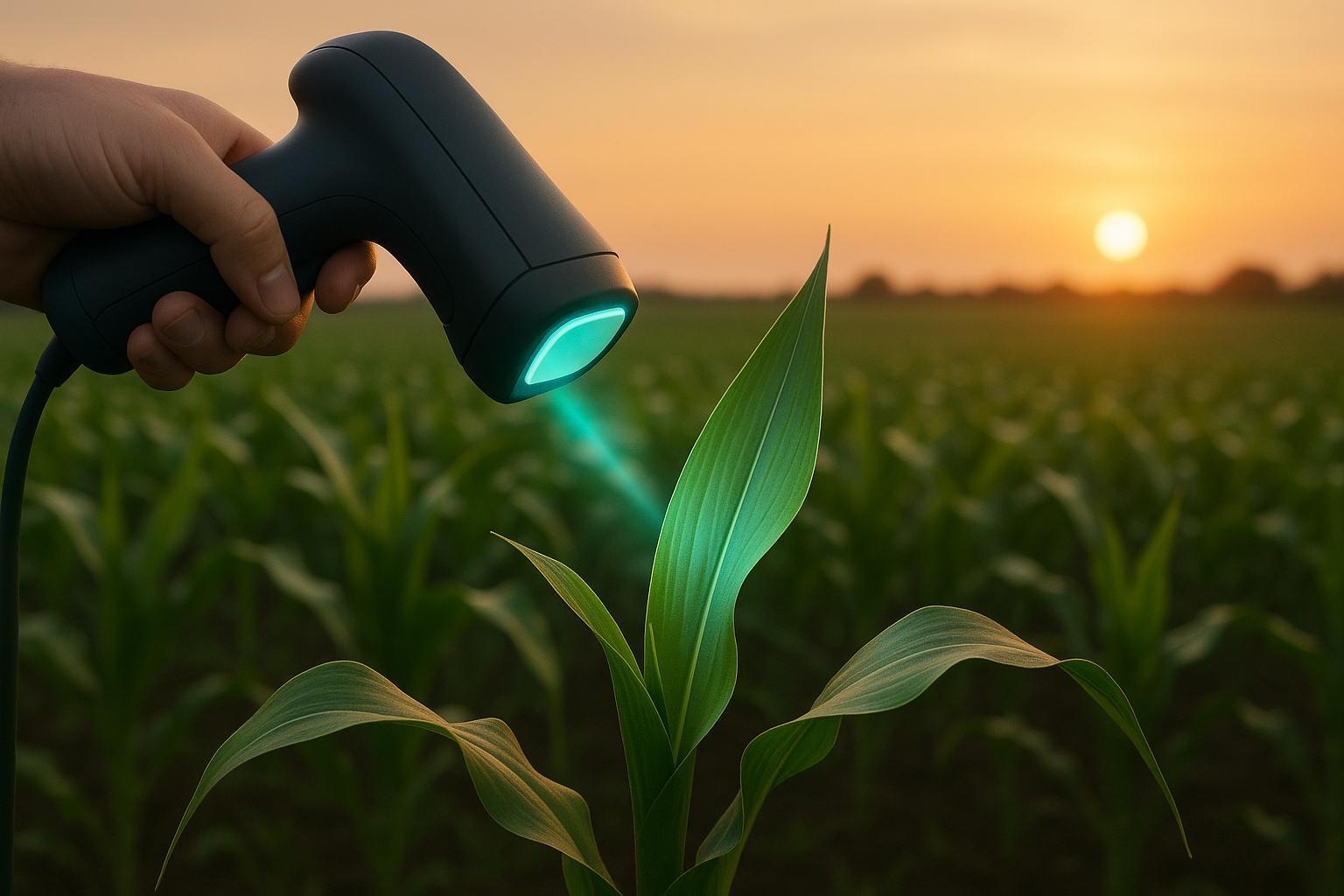
Imaging Techniques for Non-Destructive Disease Detection
Explore advanced imaging techniques revolutionizing non-destructive plant disease detection, enhancing early diagnosis and crop management.
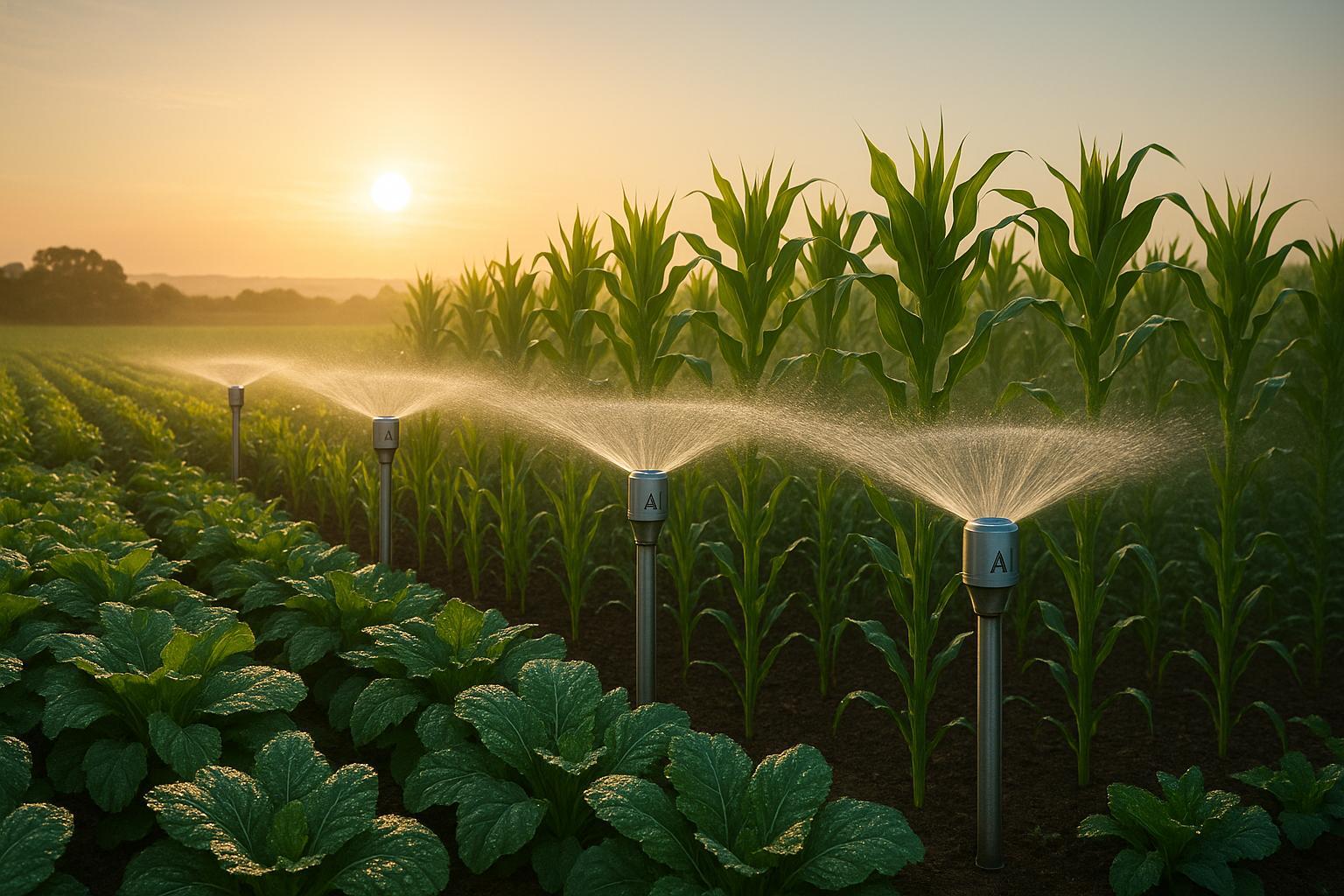
Checklist for AI-Optimized Irrigation
Explore how AI irrigation systems enhance water efficiency, boost crop yields, and simplify garden management through smart technology.

Factors Influencing Fill Time of a 20,000 Gallon Pool
Explore the key factors affecting the time required to fill a 20,000 gallon pool. Learn about water flow rates, hose diameters, and efficiency tips for pool filling.
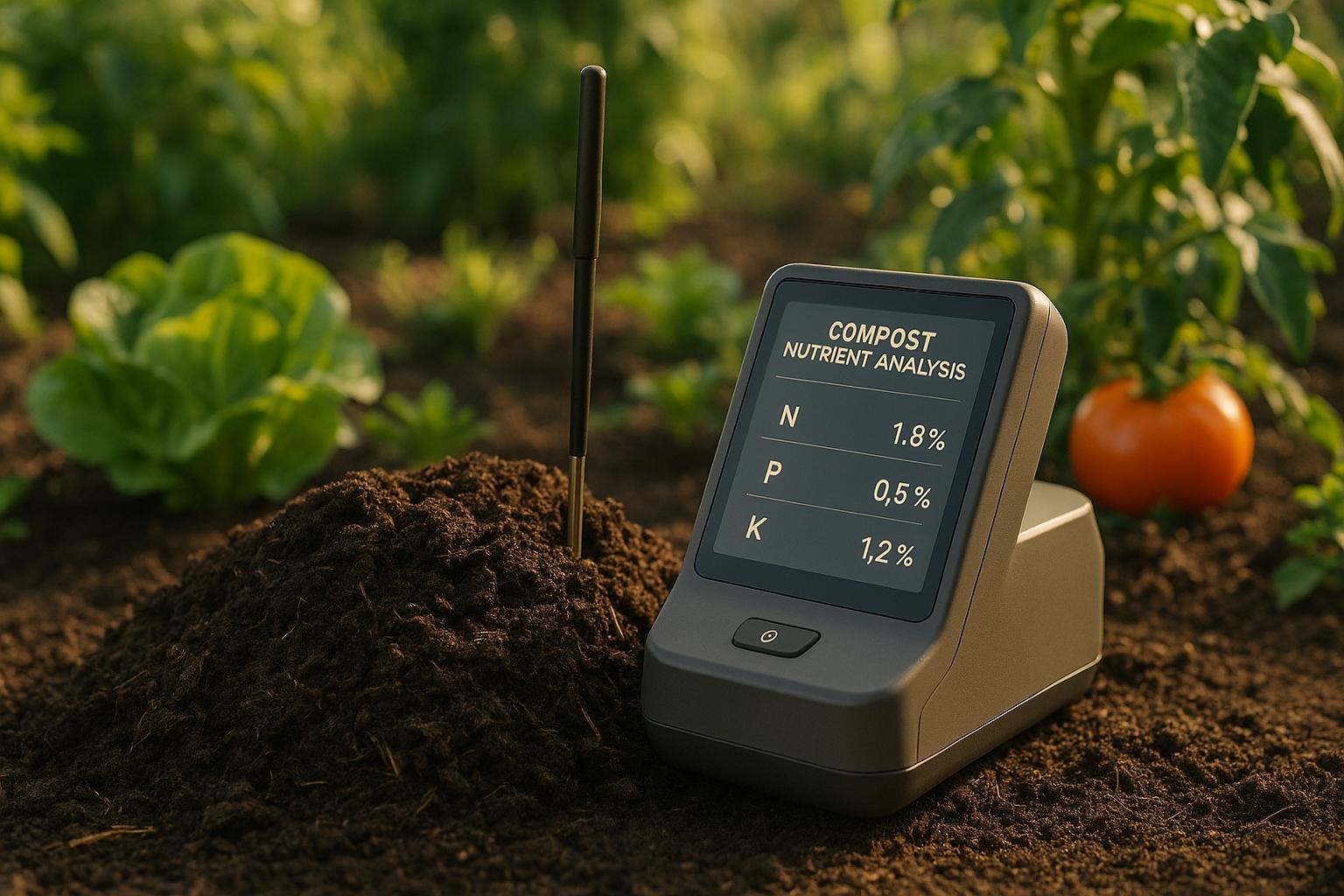
AI Tools for Compost Nutrient Analysis
Explore AI tools that enhance compost nutrient analysis, offering faster, accurate insights for gardeners and farmers at all levels.
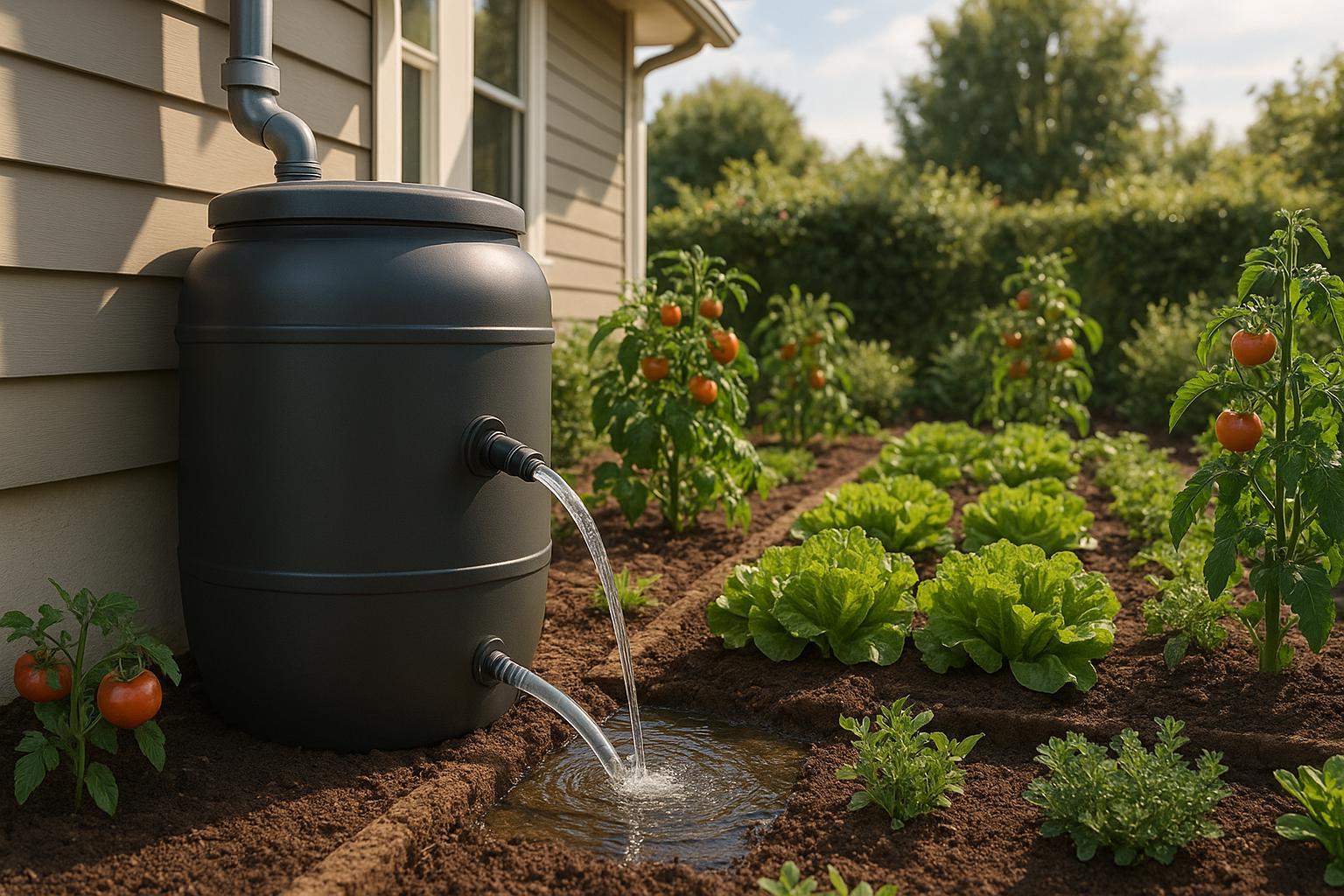
Ultimate Guide to Rainwater Filtration for Gardens
Learn how to implement an effective rainwater filtration system for your garden, enhancing plant growth while conserving water and reducing costs.
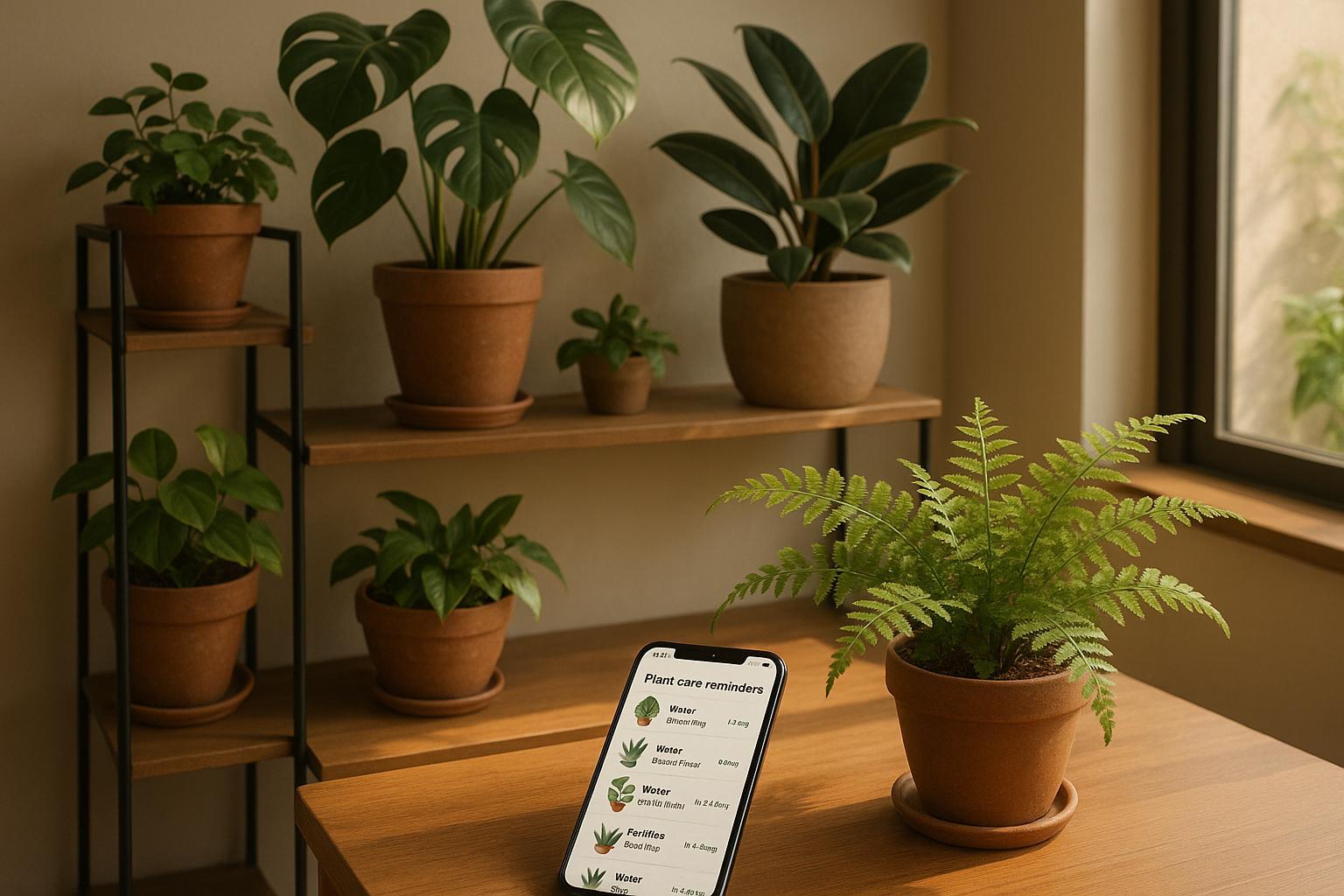
Top 5 AI Apps for Plant Care Reminders
Explore the top 5 AI apps that simplify plant care with personalized reminders, health diagnostics, and tailored advice for every gardener.